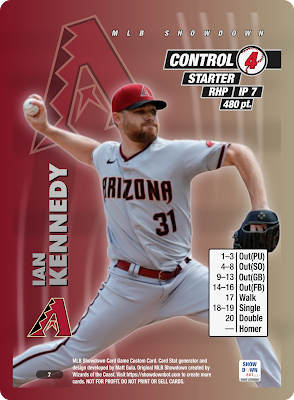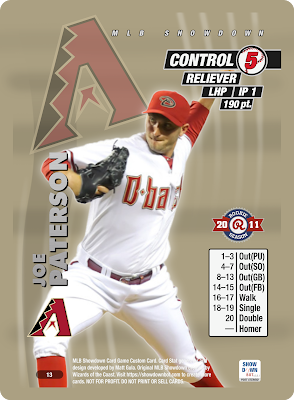Introducing the 2011 Showdown Set in 2001 style! With both the Steroid Era (1994-2009) and the Statcast Era (2015-2022) of MLB well represented by Showdown sets, I thought it was time to give the players we remember from the in-between period (the Post-Steroid Era) some love. Many players have never had a Showdown card made as part of a sizable set, so have fun with the novelty of new options for your rosters!
What sort of set is this compared to the ones Showdown players are familiar with? The biggest difference between this and the Showdown Era (OG) sets is
the lack of offense. There are only 9 batters with an On Base of 10 or more – though two are 11 On Base. For comparison, the OG 01 set had 32 and the OG 00 set had 49. And unlike the Statcast and current Pitch Clock eras, we don’t see the huge power numbers and three-true-outcome tendencies that stem from the new swing approaches. See, for example, the 2021 set(s) for lots of 6, 7, and 8 On Base cards with huge power charts.The pitching, predictably, is slightly-above average pitching, but there are no huge outliers in terms of points. Cy Young winners Justin Verlander and Clayton Kershaw clock in at 630 and 600 points respectively, certainly not the 660 and 700 point Pedros we all know and love. (See also the 2021 sets out there again for lots of high end pitching.) But, combine it with great defense and positional versatility among the position players, and the low offense makes sense.
I enjoy the unique character of this era and the challenge it will bring to team building.
A few features/items:
General:
- There are 650 cards in this set. I purposely created enough cards so that every MLB team could be played as a full, self-sufficient team using their Base Set and Pennant Run cards, with at least 9 position players covering all 8 positions in the field, 4 starting pitchers, and 5 relievers/closers.
Unique aesthetic features:
- Some teams use their secondary color as their background color in order to increase card color variety in the set.
- Image cutouts land somewhere between 2000 and 2001 in terms of framing the player (more zoomed in than 2000, but less than 2001, though they lean 2000).
- Foils are multi-color in this set.
Speaking of foils:
- Low-point Pennant Run foils for future stars’ rookie seasons: If you enjoyed 2001 C.C. Sabathia and Albert Pujols, check out 2011 Liam Hendricks or Jose Altuve.
- In Memoriam cards: Super Season foils from legendary players who died in 2023 (the year I started working on this set). I developed a slightly altered look for these cards. Let me know what you think!
- Alt-foils! A few cards have alternate foils in the secondary color, rather than the primary- or multi-color format. Look through the set to find them all (and discover their other unique feature!)
Season/edition/chart:
- Charts are usually, but not always, Showdown Bot version 1. I tended to choose higher On Base versions for batters where two versions were very similar in projected stats. I also attempted to capture the spirit of the player and his season with the card. Finally, I considered draftability in a few cases.
- Base Set rookies are indicated with the Rookie Season edition symbol. These are generally players who exceeded rookie limits early in 2011 and/or played most of the season at the major league level.
- Pennant Run rookies are indicated with the Rookie Season symbol and Pennant Run symbol (and are in the Pennant Run folder). These are generally players who debuted in 2011, and exceeded their rookie limits late in the season/didn’t play as much of the season at the major league level
- Some Pennant Run rookies are “September call-ups” who did not exceed their rookie limits until 2012. Due to small 2011 sample sizes, these cards are generated using 2011-2012 stats combined. (See Mike Trout, for example.)
- Some additional Pennant Run non-rookie cards utilize combined multi-season stats if they were deemed essential to the set, but had distorted stats due to small 2011 sample sizes.
- Pennant Run cards double as Trade Deadline cards in the sense that trade deadline acquisitions deemed significant have a second PR card with their new team.
Please let me know if there are any errors as you look through the set.
Now let’s take a look at the first team/division!
The first team up is the first team alphabetically, the first team I created for the set, and they finished first in the NL West in 2011. The Arizona Diamondbacks are a fun team with speed, pitching, and value. Their secondary color makes for a unique beige background, with only the Astros with a similar look, and only on their foils.
B.J. Upton gives you at 9 OB, Speed A card with good pop for 410 points. Ian Kennedy is an affordable, well-rounded ace. Personally, I think all eyes will be on CF Chris Young. He brings +3 defense in center, A speed, and 8 OB with a fun chart – all for just 250 points. As a team, Arizona boasts a +6 outfield. 8-OB catcher with a +11 arm Miguel Montero for sure gets drafted too. Finally, D-Backs legend Paul Goldschmidt makes his debut as a Pennant Run rookie foil. With most of the 10-11 OB cards playing 1B, I don’t know if he gets drafted, but the chart is indisputably fun. All in all, a solid squad with lots of draftable cards that would also be fun to play as a complete team.
Foils: Paul Goldschmidt (PR), Ian Kennedy, B.J. Upton
And the Pennant Run additions:
Who are you drafting from this team?






















These look so good!!! 2011 showdown is special to me since that was the first “new” set that I discovered Colby made back in the day, so this is a great walk through memory lane!
ReplyDeleteRecap and analysis are great, and the “foil” card background difference looks awesome!!! Looking forward to this series for sure!!!!
Always exciting to see MLB Showdown cards continuing to live on. Like Peter, it was the set that introduced me to Colby and, two years later, we started doing our thing for three years.
ReplyDelete